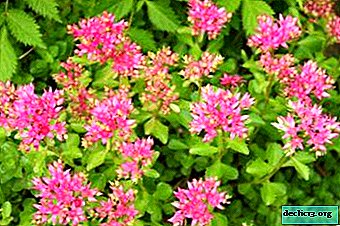Garden begonia: description, care and propagation of a flower

Begonia is increasingly found in flowerbeds of central streets, squares, parks, and cottages. From spring to late autumn, the plant is strewn with bright flowers, which was really appreciated by urban landscaping services, landscape designers and amateur gardeners.
There are hybrid varieties that are used for landscaping a winter garden, growing in pots. They bloom all year round.
Flower description
The homeland of begonia is considered the tropical forests of South America, Africa, where it is a perennial. In a temperate climate, the plant is considered annual, weather conditions do not give the opportunity to grow in open ground year-round. About planting and caring for perennial and annual begonias we wrote here.
With the advent of cold and frost, begonia is dug up and stored all winter until spring. The garden plant has compact dimensions. The bush grows up to 30 cm high. There are quite a few buds that sometimes the foliage is not even visible. The size of flowers in diameter varies from 5 to 15 cm.
The texture of inflorescences is terry and semi-double. The color is varied. In appearance, they resemble the flowers of roses, azaleas, peonies, depending on the variety. The stalk and foliage are juicy green. The shape of the leaves is asymmetric, the edges are serrated.
Reference! At the end of flowering, the fruit is formed - a box of seeds. They are very small, in 1 gram there are 90 thousand pieces of seeds.Photo
Next you can see a photo of street begonia:





Can I plant in the street?
Begonia is considered a water-loving plant. Prefers to grow in partial shade. However, now you can easily find varieties that grow excellently in an environment with high temperature and low humidity. They are not afraid of small frosts and heavy rains.
Most often, tuberous varieties are planted in open land. Rhizome flowers are planted in the summer on flower beds, and at the end of autumn they are transplanted into flowerpots and brought into the room. Sometimes, in order not to waste time, gardeners plant begonia in pots, they decorate flower beds, balconies.
In bad weather, they hide back in the house. But for the plant, such transfers are unfavorable. Therefore, as practical experience shows, for our climatic conditions it is better to choose adapted varieties or find the right place right away.
Subspecies
As a result of many years of selection and crossing of various classes of plants, as a result, a huge number of hybrids were obtained.
Below are the most common ones.
Tuber look

There are double, semi-double and smooth flowers. The color is white, pale pink, yellow, scarlet, bright red. The stalk is fleshy strong. This species is characterized by a long flowering process.: from the first of June to the end of November. When growing tuber begonia in the open air, it is important to pay attention to certain nuances. In winter, the plant needs greenhouse storage.
Ampere

The length of shoots hanging down to 80 cm. Drop-down varieties of ampel begonia look good when decorating street vertical structures. They are grown in hanging flowerpots or on coasters. Hybrid varieties remain attractive even with the onset of small frosts.
Everlasting

There are numerous varieties of this subspecies. The bushes grow small, up to 15-20 cm high. The foliage is oval in shape, smooth texture, the color is from light green to brown. They are used for decorating flower beds in parks, squares. Plants are not capricious, even beginners can take care of them.
More details about the types of begonias can be found here.
Planting in the garden
Planting in the open ground of a garden herb occurs in late May, when warm, sunny weather stabilizes. Tuberous begonia is pre-germinated before planting in greenhouse conditions, at a temperature of + 22-24 ° C. Everblooming varieties planted with the first flowers, this allows you to immediately give a decorative look to the flower beds.
To get unsurpassed beauty in the garden, you should pay attention to the following:
- It is better to have begonias in partial shade, because the diffused light makes it possible to form a lush bush, and not stretch up. But give a place in the sun to photophilous flowers.
- Soil for begonia should be loose, with a neutral pH. In autumn, the soil is dug up, weed rhizomes are removed, humus, peat, sand are added so that the soil is more light breathable. Plants can grow in one place for about 6-7 years. They practically do not drain the earth. With a lack of free space on the flower beds, it is recommended to plant flowers in flowerpots.
- Watering is carried out regularly, but do not overdo it. Waterlogging the soil can lead to decay of the root system. For begonia, growing on flower beds, and for pot growth, it is imperative to perform a drainage layer. In autumn, minimize moisture.
- After the preparatory work, the process of street planting begins with the preparation of holes, a depth of 20-25 cm. Fragile shoots or sprouted tubers are carefully and carefully placed in them. Sprinkle with earth and wood ash. The gap between the begonias should be 20 cm.
- In late autumn, tuber begonia is extracted from the ground. To clear tubers from the earth, to wash and dry. Then put in a cool place to store until next season.
Outdoor Care
 Proper care of street begonia is to regularly moisten the soil, loosen the soil and add fertilizer. Peel under the flowers should not be allowed.They don’t like that. However, the soil should be loosened carefully so as not to touch the stems and leaves of the plants.
Proper care of street begonia is to regularly moisten the soil, loosen the soil and add fertilizer. Peel under the flowers should not be allowed.They don’t like that. However, the soil should be loosened carefully so as not to touch the stems and leaves of the plants.
Begonia spends a lot of energy on flowering. Therefore, you need to make nutrients several times a year. In spring, the procedure is done with a full complex of mineral fertilizers, for good rooting and active development of green mass.
Advice! Further, during budding and active flowering, flowers are fed every 2 weeks with substances containing potassium and phosphorus.Breeding
You can build begonias in the following ways:
- tuber division;
- vegetative;
- seed.
Garden begonia belongs to the class of tuberous plants, so the first method of reproduction is most suitable. In greenhouses, this method is the main one when growing a garden species.
- Tuber method:
- When buying begonia tuber in a store, or taking it out of a wintering place, it must be disinfected.
- Dip in a solution with potassium permanganate, then dry.
- Then the tuber can be planted in a moistened substrate (sawdust, sand, peat) until new shoots appear.
- Propagate garden shoots by green cuttings:
- Sprouted material, which are tubers, is removed from a previously prepared place.
- The shoots are carefully broken off and planted in separate containers enough so that the top of the sprout peeps 2-3 cm from the ground.
- The rooting process is fast and it will already turn out not 1 flower, but 4-5 pieces.
 Everblooming begonias reproduce through conventional cuttings:
Everblooming begonias reproduce through conventional cuttings:- The top of a healthy, beautiful plant is cut with a sharp knife.
- Remove all unnecessary leaves, leaving no more than 3 on top. The length of the shoot is 10-15 cm.
- Then this process is placed in a glass with water or planted in a non-primed substrate until the roots appear.
- After 10-14 days, they hatch.
Although begonia seeds are quite small in size, they are still used to produce seedlings. The seed method is applicable provided that there is a greenhouse. Otherwise, it is better to choose two other methods. Also, propagating plants using seeds, many maternal characteristics are lost: color, texture of inflorescences.
Learn more about the propagation of begonias here.
Common diseases
Street begonia, like indoor plants, is prone to disease. The main reason for this is a violation of proper care, this is especially characteristic of greenhouse maintenance.
Deviations from the parameters can lead to the development of such diseases:
- Powdery mildew, a fungal disease of flowers due to which a white coating appears on the surface of the leaves. With the spread of the fungus, yellowish spots appear, round in shape. They are visible on the lumen or on the back of the leaves. Powdery mildew develops in conditions of high humidity and lack of ventilation. To combat this ailment should be by spraying with fungicide or sulfur.
- Root rot. The disease develops due to an excess of moisture in the soil and a low temperature in the room. Initially, the roots of the plant are damaged. This disease also spreads to the leaves, they twist, and the stems undergo a process of decay. You can get rid of begonia from a similar problem by removing damaged areas and treating with a fungicide solution.
More nuances about begonia diseases can be found here.
Pests
- Aphid. She eats the juice of the plant, which leads to deformation of the leaves. This pest is fought with the help of processing infusion of celandine, onion broth.
- Spider mite. Located on the bottom of the sheet. Prefers also young shoots. The appearance of the tick is indicated by pallor, falling leaves. For destruction, a soap solution is used.
- Thrips. Small flying pests. Signs of their presence on begonias: dark brown spots on the leaves, which are distributed along the edges or in the center. Subsequently, the leaf turns yellow and dies. In this case, urgent treatment of begonias with an insecticide solution is necessary. For example, the drug "Aktara", dilute 1 g per liter of liquid.
Combination with other plants
 Street begonia is good for creating flower arrangements. It easily connects with various shrubs that give it a partial shade, as well as ornamental and deciduous plants, perfectly complements low-growing perennial flowers.
Street begonia is good for creating flower arrangements. It easily connects with various shrubs that give it a partial shade, as well as ornamental and deciduous plants, perfectly complements low-growing perennial flowers.
Begonias look great with such curb summer plants: surfinia, lobularia, Iberis, lobelia. An excellent tandem is obtained at the merger of begonias with asters, lilies, ceniraria.
Landscape design
Designers use these flowers to create alpine slides, park beds with unique patterns of flowers. Also quite often you can find begonias in flowerpots for decorating terraces, garden plots, open areas, flower beds.
Important! Potted begonias are used to give colors a plain green lawn and flower carpets. Specialists in landscape design around the world use this unusually colorful flower, because with what not to plant - everything will turn out perfectly.In general, garden begonia is an ideal plant for a garden, home, park. Unpretentious character and long-lasting flowering add only positive qualities. No wonder begonias are selected and grown on an industrial scale.

 Everblooming begonias reproduce through conventional cuttings:
Everblooming begonias reproduce through conventional cuttings:















